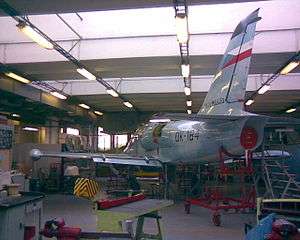Aero L-59 Super Albatros
The Aero L-59 Super Albatros is a Czechoslovak military jet trainer developed from the firm's earlier L-39 Albatros. Compared to its predecessor, it featured a strengthened fuselage, longer nose, a vastly updated cockpit, advanced avionics (including head-up display), and a more powerful engine Lotarev DV-2. At the time of its first flight on 30 September 1986, it was designated the L-39MS.[1] Aero no longer produces this aircraft.[2]
| L-59 Super Albatros | |
|---|---|
 | |
| The first prototype L-39MS designated X-21, is currently in the Odolena Voda Technological Institute as teaching material. | |
| Role | Military trainer aircraft COIN |
| Manufacturer | Aero Vodochody |
| First flight | 30 September 1986 |
| Status | Out of production, in service |
| Primary users | Czech Air Force Egyptian Air Force Tunisian Air Force |
| Produced | 1986–1996 |
| Developed from | Aero L-39 Albatros |
| Variants | Aero L-159 Alca |
In 1992, a dedicated single-seat attack variant was proposed under the project name ALCA (Advanced Light Combat Aircraft), and was successfully marketed to the Czech Air Force. First flight of this variant, designated L-159A, was on 2 August 1997. The aircraft features mostly Western avionics, with systems integration undertaken by Boeing. Since then a new two-seat trainer has been flown as the L-159B Albatros II.
Variants
- L-59
- Standard production version (six L-39MS for Czechoslovak Air Force). Later four in Czech Air Force, two in Slovak Air Force.[1]
- L-59E
- Export version for Egypt. 49 x L-59s for Egyptian Air Force.[1]
- L-59T
- Export version for Tunisia. 12 x L-59s for Tunisian Air Force.[3]
Operators
- Egyptian Air Force 48 delivered in 1993-1994.[4]
- Tunisian Air Force 12 delivered in 1995-1996.[4]
Combat history
In April 2014, Tunisian L-59s were used in reconnaissance and COIN strikes in support of major military offensives in the border region of Mount Chaambi against Ansar al-Sharia and al-Qaeda-linked militants that aim at destabilizing Tunisia's transition to democracy.[5]
Specifications (L-59E)
Data from Jane's All The World's Aircraft 1993–94 [6]
General characteristics
- Crew: 2
- Length: 12.20 m (40 ft 0 in)
- Wingspan: 9.54 m (31 ft 4 in) (including tip tanks)
- Height: 4.77 m (15 ft 8 in)
- Wing area: 18.80 m2 (202.4 sq ft)
- Empty weight: 4,030 kg (8,885 lb) (includes gun)
- Max takeoff weight: 7,000 kg (15,432 lb)
- Fuel capacity: 1,537 L (406 US gal; 338 imp gal) including tip tanks
- Powerplant: 1 × Lotarev DV-2 turbofan, 21.57 kN (4,850 lbf) thrust
Performance
- Maximum speed: 865 km/h (537 mph, 467 kn) at 5,000 m (16,000 ft)
- Stall speed: 185 km/h (115 mph, 100 kn) (flaps down)
- Range: 2,000 km (1,200 mi, 1,100 nmi) at 7,000 m (23,000 ft) (with maximum internal and external fuel)
- Service ceiling: 11,800 m (38,700 ft)
- Rate of climb: 28.0 m/s (5,510 ft/min)
Armament
- Guns: 1 × GSh-23L cannon in underfuselage pod
- Hardpoints: 4 underwing hardpoints with a capacity of inner hardpoints 500 kg (1,100 lb)capacity, outer hardpoints 250 kg (550 lb),
See also

Related development
Aircraft of comparable role, configuration and era
References
- Notes
- Lake 2000, p. 128.
- "Aero". Aero Vodochody. Archived from the original on 26 January 2013. Retrieved 21 February 2013.
- Lake 2000, p. 129.
- History and Development
- http://allafrica.com/stories/201404141763.html
- Lambert 1993, pp. 64–65.
- Bibliography
- Lake, Jon. "Aero L-39 Albatross family: Variant Briefing". World Air Power Journal, Volume 43, Winter 2000. London:Aerospace Publishing. pp. 116–131. ISBN 1-86184-055-1.
- Lambert, Mark (ed.). Jane's All The World's Aircraft 1993–94. Coulsdon, UK: Jane's Data Division, 1993. ISBN 0-7106-1066-1.